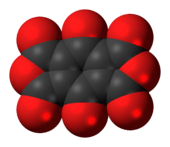Benzoquinonetetracarboxylic dianhydride
 | |
 | |
| Identifiers | |
|---|---|
| 476-37-9 | |
| 3D model (Jmol) | Interactive image |
| ChemSpider | 32686035 |
| |
| |
| Properties | |
| C10O8 | |
| Molar mass | 248.10 g·mol−1 |
| Except where otherwise noted, data are given for materials in their standard state (at 25 °C [77 °F], 100 kPa). | |
| | |
| Infobox references | |
Benzoquinonetetracarboxylic dianhydride is an organic compound with formula C
10O
8 (an oxide of carbon) which can be seen as the result of removing two molecules of water H
2O from benzoquinonetetracarboxylic acid.
It is a red solid, stable in dry air up to 140 °C, insoluble in ether, carbon tetrachloride, dichloromethane, carbon disulphide. It reacts with acetone, ethyl acetate, tetrahydrofuran, ethanol, and water. It dissolves in methylated derivatives of benzene to give solutions ranging from orange to violet. When the molecule is exposed to moist air it quickly turns blue.
The compound was synthesized in 1963 by P. R. Hammond who claimed it was "one of the strongest π-electron acceptors so far described."[1]
See also
- Ethylenetetracarboxylic dianhydride
- Tetrahydroxy-1,4-benzoquinone biscarbonate
- Tetrahydroxy-1,4-benzoquinone bisoxalate
References
- ↑ P. R. Hammond (1963), 1,4-Benzoquinone Tetracarboxylic Acid Dianhydride, C10O8: A Strong Acceptor. Science, Vol. 142. no. 3591, p. 502 doi:10.1126/science.142.3591.502
This article is issued from Wikipedia - version of the 5/24/2016. The text is available under the Creative Commons Attribution/Share Alike but additional terms may apply for the media files.